Thirty-six days after winning the governorship during this week in 1942, death cruelly intervened and denied the Wisconsin Progressive Party one of its greatest electoral achievements in the party’s twelve-year history.
While Minnesota’s neighboring Farmer-Labor Party went out with barely a whimper and most of the country’s other minor parties fared poorly at the ballot box that autumn, the most spectacular — and ultimately tragic — achievement by a third-party candidate in the 1942 mid-term elections occurred in Wisconsin’s three-way gubernatorial campaign where 49-year-old former attorney general Orland S. Loomis unexpectedly trounced Republican incumbent Julius P. Heil and Democrat William C. Sullivan.
Loomis swamped his Republican and Democratic rivals, garnering 397,664 votes to Heil’s 291,945 and 98,153 for Sullivan. A young Frank P. Zeidler, who eventually served three terms as the Socialist mayor of Milwaukee and later headed his party’s ticket in the 1976 presidential campaign, garnered 11,295 votes while finishing ahead of two other minor-party candidates in the race.
A former president of the Wisconsin Senate and an FDR-appointed, one-time director of the state’s Rural Electrification Administration, Loomis had lost a heartbreaker to Heil two years earlier, losing to the Republican governor by 12,000 votes out of nearly 1.4 million cast.
“Spike” Loomis — a nickname given to him as a young boy — waged a near picture-perfect campaign in the fall of 1942, out-hustling his major-party opposition at every opportunity. Running rings around his opponents while visiting virtually every town, city and rural community in the state, Loomis ran up huge pluralities in heavily-populated Milwaukee and Dane counties while carrying 51 of the state’s 71 counties.
Focusing on fiscal frugality and economic issues, Loomis hammered Heil throughout the campaign, accusing the Republican governor of establishing the most “incompetent one-man rule to be found anywhere in the nation.” Asserting that Heil had been an absentee chief executive, the Progressive candidate also lambasted his Republican opponent for bringing “ridicule upon the state” as a result of some of his public utterances.
Heil, he said, was an embarrassment to “Fighting Bob” La Follette’s progressive tradition, a legacy that had made Wisconsin a “laboratory for democracy.” Heil, a wealthy steel manufacturer from Milwaukee, had defeated La Follette’s son, Philip, in the state’s 1938 gubernatorial race.
“Our present state government,” declared Loomis in a radio interview in early October, “has lacked competency based upon knowledge of and experience in governmental affairs, has shown brutal disrespect for the will of the people, astonishing lack of diplomacy, judgment, dignity and integrity — in its all-out determination to replace government of, by and for the people with the will of one man!”
The voters of Wisconsin overwhelmingly agreed.
The campaign, however, had taken a devastating physical toll on Loomis. Friends and supporters noticed how exhausted he looked after the election. The dark circles and deep lines on his face revealed more than a hint of strain.
Tragically, the country lawyer from Mauston suffered a series of severe heart attacks a month later — a fifth and fatal one occurring two-and-half days after the first one — setting off a series of legal fireworks for his replacement.
Many Republican leaders in the state believed that Gov. Heil, a man who had been vociferously denounced by his detractors as a “buffoon” and who had been unceremoniously rejected by Wisconsin voters only four weeks earlier, should have been allowed to continue in office — an argument repudiated by the state’s highest court.
Much to the chagrin of the Wisconsin Progressives, the GOP nevertheless retained the governorship.
Lieutenant Governor Walter S. Goodland, a pipe-smoking 80-year-old Racine Republican who had been reelected to a third term that autumn, was named acting governor for the full two-year term when the Wisconsin Supreme Court, in a unanimous 17-page ruling on December 29 — six days before Loomis would have been inaugurated — held that the lieutenant governor should be empowered to take over the powers and duties of acting governor.
Candidates for governor and lieutenant governor ran separately in those days, not as a “team” as they have since 1970. Goodland had little difficulty winning another term that autumn, comfortably defeating the Progressive Party’s Henry J. Berquist, a three-term state legislator and ex-pacifist from Rhinelander, and Democrat John M. Brophy
Incredibly, the opportunistic octogenarian, who looked and growled like a St. Bernard, as TIME Magazine so indelicately described him at the time, had himself sworn in as lieutenant governor by his nephew an hour and ten minutes after he learned of Loomis’ death on December 7 — nearly a full month before he should have legally taken his oath of office for another term as lieutenant governor.
Founded in 1934 by Philip and Robert M. La Follette, Jr., sons of the famous Robert M. La Follette, Sr., Wisconsin’s short-lived Progressive Party — a party that held nineteen seats in the state legislature at the time of Loomis’ untimely death — never fully recovered from the tragedy of 1942 and folded up its tent four years later.



“The will of one man”… Evidently a time-honored tradition in Wisconsin! And here we are again finding opportunity ripe for “focusing on fiscal frugality and economic issues.”